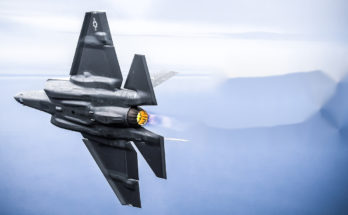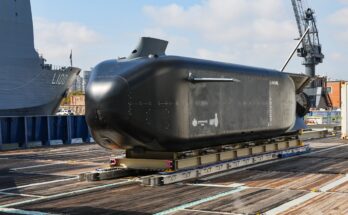by Derek Bisaccio, International Military Markets Analyst, Forecast International.

Syrian President Bashar al-Assad meets with Russian President Vladimir Putin, Defense Minister Sergei Shoigu, and Chief of General Staff Valery Gerasimov in November 2017. Source: Russian Presidency website
More than seven years after domestic protests broke out against the Syrian government and President Bashar al-Assad, the Syrian military, with Iranian and Russian backing, has achieved victory over insurgent forces. Pockets of anti-government forces certainly remain, including in the southwest and southeast of Syria, as well as the province of Idlib in the northwest, and a large question mark hangs over the future of the Syrian government’s relations with the U.S.-protected People’s Protection Units (known by the Kurdish acronym YPG) and of portions of rebel territory where Turkey has deployed troops. Nevertheless, the war for the ouster of President Assad is at its conclusion.
Writing for the online platform War on the Rocks, Luke O’Brien and Aaron Stein discussed President Assad’s counterinsurgency strategy, which falls firmly within a rather brutal strain of the “enemy-centric” camp of counterinsurgency. They wrote that the Syrian military’s use of chemical weapons “demonstrated their value for warfighting,” noting in particular that, along with other benefits, “[f]or Assad, chemical weapons also compensate for the limitations of his army’s older, less sophisticated weapons.”[i] Despite international conventions on the use of chemical weapons, the munitions proved to suit the Syrian military’s needs well. The government, even prior to Russia’s 2015 direct intervention on its behalf, was willing to risk external invasion for the perceived benefits of the chemical weapons in fighting insurgents.
Chemical weapons may also have served as a deterrent of some form against external invasion. The Syrian military would not be able to win a war against, say, the United States, but the rather grisly implication of its willingness to use chemical weapons on its own people is that it would certainly not hesitate to do so against the people of other, neighboring countries in the event an existential external threat emerged. The collapse of the Syrian government, furthermore, would conceivably result in the diffusion of at least some of these weapons into the hands of myriad militant groups that, like the government,[ii] have little qualms about deploying them.[iii] This sort of “deterrent,” such as it is, would certainly not be sufficient to preserve the Syrian government were another country to perceive a need to remove it, but a lack of compelling strategic interest to do so makes the costs of intervention much greater than the value.
The Syrian government’s chemical weapons might have been able to address non-state actors, and perhaps offer a degree of deterrence against existential threats, but they are unable to address the more likely threats faced by the Syrian military. As the civil war winds down, the Syrian military’s conventional weaknesses have been laid further bare. Even prior to the war, much of the military’s inventory was aged, necessitating the negotiation of new arms contracts with suppliers like Russia. The civil war resulted in the destruction of much of the military’s initial equipment, from fighter jets to helicopters to tanks. As this was ongoing, Syria’s neighbors continued to bolster their forces with the latest generation of hardware, such as the introduction of the F-35 into Israeli service,[iv] heightening the divide between Syria and its traditional rivals.
The discrepancy shows. The Israeli military has conducted air strikes largely unhindered in Syria throughout the conflict,[v] continuing to strike deep into Syria despite Syria’s air defense network.[vi] Besides Israel, foreign militaries hostile to Damascus have been directly operating in Syria since 2014,[vii] paying no heed to Syrian protestations. The U.S. shot down an Su-22 in 2017 and Israel downed another this month.
To rectify the situation, the Syrian government is negotiating with Russia, its traditional supplier and newly found counterinsurgency partner, for new supplies of military systems. Throughout the early phases of the war, Russia was reluctant to cancel the supply of weapons to the Syrian government.[viii] Following the Russian intervention, Moscow provided some secondhand equipment to replenish the Syrian military, including tanks, armored vehicles, self-propelled mortars, and perhaps even aircraft, according to pro-government media.[ix] Syria also received new batches of the Pantsir-S1, an air defense system. Moving forward, Syria is interested in a complete renovation of its forces, with the exception of its Navy. In terms of major hardware, Damascus needs new fighter jets, jet trainers,[x] helicopters, missile systems, tanks, armored vehicles, and self-propelled ordnance.
Cost burdens and politics will be significant impediments. The lowest estimate of reconstruction costs for the country is $200 billion,[xi] for which Syria will almost undoubtedly not be able to leverage Western financial support. The government’s total budget for 2018, SYP3,187 billion,[xii] equals only a little over $7 billion (at the official exchange rate), limiting the amount available for arms imports. Russia can certainly be expected to extend some financial assistance for the procurement of military equipment, but at some point it will want compensation for its arms, via either payment or economic concessions.
Politics will similarly inhibit the sale of significant equipment, such as air defense systems, that the Syrian military needs to secure its territory. After the trilateral French, British, and American strikes on the Syrian government in April of this year, Russia publicly toyed with the idea of resuming supply of the S-300 to Syria under a moribund contract dating prior to the civil war. In 2018, a number of Russian officials discussed with Russian media a resumption of the Russian government’s deliberations over the sale, stressing that “no moral barriers” exist that could prevent it should both parties want to conclude a deal.[xiii] The public musings prompted strong warnings from Israel that it would destroy any S-300s transferred to Syria,[xiv] threats that the Israeli military underscored by displaying footage showing the bombing of a Syrian Pantsir-S1.[xv] Russian Defense Minister Sergei Shoigu later walked back the subject of the S-300 sale, saying that the Syrian government had not actually made a request for the system at all.[xvi] Whether Damascus made a request to resume deliveries of the S-300 is unclear – the government stayed mum on the matter, though its state-owned media outlet did cover Defense Minister Shoigu’s comments[xvii] – but the public S-300 saga demonstrated that significant political barriers exist to the supply of major equipment.
The political challenges might not be insurmountable for Damascus, as the Russian sale of the S-300 to Iran went through similar public wrangling, but in that case, Tehran had the sort of finances to cover the purchase of the missile system and the supply of the system came as an incentive for Iranian participation in the 2015 nuclear accord. In Syria’s case, the government lacks leverage other than appeals to shared security interests and Russia’s determination to keep President Assad in power. Countries regularly turn to multiple suppliers in order to strengthen their negotiating position or to lessen dependence on one in particular, but in Syria’s case, the only realistic alternative to Russia is China, limiting Damascus’ flexibility in negotiations, as China has comparatively never been a major supplier of conventional equipment to the Syrian military. Given Damascus’ determined goal of asserting control of the entirety of Syrian territory, the government will need to overhaul its military, but the only way to do so is through further dependency on the Russian government.

Derek Bisaccio has had a lifelong interest in politics and all things military. Currently, Derek is the editor of Forecast International’s International Military Markets – Middle East & Africa and International Military Markets – Eurasia Market Intelligence products.
[i] Luke O’Brien and Aaron Stein, “The Military Logic Behind Assad’s Use of Chemical Weapons,” War on the Rocks, June 15, 2018. Retrieved from http://warontherocks.com/2018/06/the-military-logic-behind-assads-use-of-chemical-weapons/
[ii] Rodrigo Campos, “Syrian Government to Blame for April Sarin Attack: U.N. Report,” Reuters, October 26, 2017. Retrieved from http://www.reuters.com/article/us-mideast-crisis-syria-un/syrian-government-to-blame-for-april-sarin-attack-u-n-report-idUSKBN1CV3GP
[iii] Anthony Deutsch, “Exclusive: Chemical Weapons Used by Rebels in Syria – Sources,” Reuters, November 5, 2015. Retrieved from http://www.reuters.com/article/us-mideast-crisis-syria-chemicalweapons/exclusive-chemical-weapons-used-by-rebels-in-syria-sources-idUSKCN0SU2PZ20151105
[iv] David Cenciotti, “The Israeli F-35I ‘Adir’ Declared Operational. So What’s Next?” The Aviationist, December 6, 2017. Retrieved from http://theaviationist.com/2017/12/06/the-israeli-f-35i-adir-declared-operational-so-whats-next/
[v] Albeit not without answer from Damascus. Earlier in 2018, Syrian air defenses downed an Israeli F-16 after a confrontation over the apparent infiltration of an Iranian drone into Israeli airspace.
[vi] Jack Khoury, “Syria Accuses Israel of Striking Military Position Near Aleppo,” Haaretz, July 15, 2018. Retrieved from http://www.haaretz.com/middle-east-news/syria/.premium-syria-accuses-israel-of-striking-airport-near-aleppo-1.6272761
[vii] Craig Whitlock, “U.S. Begins Airstrikes Against Islamic State in Syria,” The Washington Post, September 23, 2014. Retrieved from http://www.washingtonpost.com/world/national-security/us-begins-airstrikes-against-islamic-state-in-syria/2014/09/22/8b677e26-42b3-11e4-b437-1a7368204804_story.html
[viii] Fred Weir, “Russia Sees ‘No Reason’ to Halt Weapon Support for Syria,” The Christian Science Monitor, March 13, 2012. Retrieved from http://www.csmonitor.com/World/Europe/2012/0313/Russia-sees-no-reason-to-halt-weapon-support-for-Syria
[ix] Andrew Illingworth, “Pictures: Syria Receives More Attack Helicopters from Russia,” Al-Masdar News, August 10, 2017. Retrieved from http://www.almasdarnews.com/article/pictures-syria-receives-attack-helicopters-russia/
[x] Derek Bisaccio, “Russia Details Status of Arms Sales to the Middle East,” Weapons4Trade, November 15, 2017. Retrieved from http://www.weapons4trade.com/2017/11/russia-details-status-of-arms-sales-to.html
[xi] Benedetta Berti, “Is Reconstruction Syria’s Next Battleground?” Carnegie Endowment for International Peace, September 5, 2017. Retrieved from http://carnegieendowment.org/sada/72998
[xii] Syrian Arab News Agency, “President Assad Issues Law on 2018 State Budget Set at SYP 3,187 Billion,” December 10, 2017. Retrieved from http://sana.sy/en/?p=120756
[xiii] RT, “Lavrov: After US-Led Strikes, Russia has ‘No Moral Barriers’ on S-300 Deliveries to Syria,” April 20, 2018. Retrieved from http://www.rt.com/news/424700-s300-lavrov-russia-syria/amp/
[xiv] Haaretz, “We May Hit Russian Systems in Syria, Israel Says After Threats of ‘Catastrophic Consequences,'” April 26, 2018. Retrieved from http://www.haaretz.com/israel-news/.premium-israel-may-hit-russian-systems-in-syria-defense-minister-warns-putin-1.6027919
[xv] RT, “‘It was Either Disabled or Out of Ammo’: How Israelis Hit the Syrian SA-22 Air Defense System,” May 11, 2018. Retrieved from http://www.rt.com/news/426520-syria-israel-pantsir-russia/
[xvi] TASS Russian News Agency, “Syria Made No Request for Russia to Deliver S-300 Missile Systems – Defense Minister,” July 11, 2018. Retrieved from http://tass.com/defense/1012675
[xvii] Syrian Arab News Agency, “Shoigu: Moscow Ready to Discuss Supplying Syria with S-300 Missile System,” July 11, 2018. Retrieved from http://sana.sy/en/?p=142116
For 50 years, Forecast International intelligence reports have been the aerospace and defense industry standard for accurate research, analysis, and projections. Our experienced analysts compile, evaluate, and present accurate data for decision makers. FI's market research reports offer concise analysis of individual programs and identify market opportunities. Each report includes a program overview, detailed statistics, recent developments and a competitive analysis, culminating in production forecasts spanning 10 or 15 years. Let our market intelligence reports be a key part of reducing uncertainties and mastering your specific market and its growth potential. Find out more at www.forecastinternational.com



